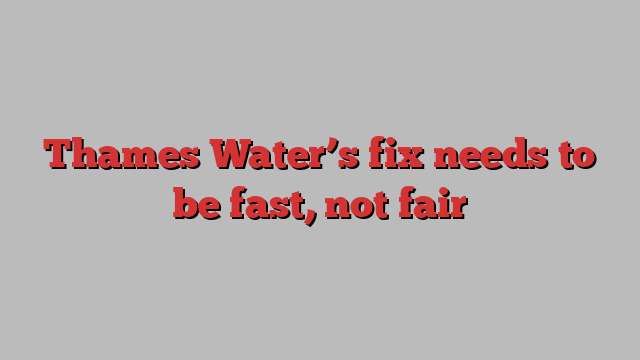
Unlock the Editor’s Digest for free
Roula Khalaf, Editor of the FT, selects her favourite stories in this weekly newsletter.
Tim Short was an investment banker at Credit Suisse First Boston where he specialised in whole business securitisations. He has PhDs in physics and philosophy and has published several books.
Thames Water’s potential collapse is top of “Sue’s shit list”, the risk register compiled by Labour chief of staff Sue Gray of problems a new government will have to tackle immediately.
But the problem is much wider, because the same financing model now wobbling at Thames Water is underpinning a lot of British infrastructure. The water sector relies on whole-business securitisations based on their regulated assets. So does Heathrow Airport. New projects like the proposed Sizewell C reactor, a key part of the UK’s net-zero plan, will apply the same model.
The Regulatory Asset Base (RAB) model employed in the Heathrow funding is practically identical to the Regulatory Capital Value (RCV) model employed in the water sector. The relevant regulator (Civil Aviation Authority for Heathrow, Ofwat for water) determines the capital base of the company then sets its permitted returns, assuming a certain level of gearing and reasonable returns on the assumed levels of equity and debt.
As of the 2022 Annual Report for Heathrow Finance PLC, the airport’s RAB was £19.18bn. It is geared at 64.9 per cent for Class A senior debt, with a further junior Class B debt taking gearing up to 76.0 per cent, so there’s 24 per cent equity in the structure. This may look high, but it’s acceptable in stable assets, and gearing itself is not the problem.
The problem is that within the whole-business securitisation structure, a company needs to issue new debt continuously to replace that which matures. Page 187 of the annual report showed that at the 2022 year-end Heathrow had £1.23bn of debt repayable within one to two years and £3.42bn repayable within two to five years. Anything which threatens the market’s belief in the RAB/RCV model has the potential to become a real problem really quickly.
In light of the contagion risks, a solution for Thames Water is needed with some dispatch. Fortunately one is in sight, which is more appealing than the blunt instrument of the Special Administration Regime, which is a form of temporary nationalisation. That route is possible but would do little to shore up confidence in the RAB model. Some form of lenient treatment is needed for Thames Water, despite the substantial public unpopularity that will ensue.
The Lex column raises a valid objection: one cannot be seen to accord special treatment to Thames because the other companies will complain about unfairness, and subject the regulator’s determination to judicial review. But delays are unendurable, given the risks elsewhere, let alone the disturbing prospect that the judicial review could succeed.
So Thames needs to be given special treatment without being seen to get special treatment. A way to approach this problem is on vaguely philosophical terms, where forbearance is fair in proportion to its size.
Thames has the most customers, the highest volumes of supply (and leakage) and the longest network. One could imagine deploying some form of special regime which could loosely be phrased as “leniency per metre of pipe.” This will take some selling to the public, but is cute enough to sidetrack a lawyer. A party seeking judicial review would start by taking advice on the prospects of success and their brief would want a simpler story than “pipe length is not a relevant metric”, because why?
Stakeholders in Thames appear to have gone in different directions. Old players in the equity have been joined in the debt by Elliott Management, a specialist in distressed situations that has a healthy appetite for risk and litigation.
Canadian pension fund OMERS has somewhat uncharacteristically flounced out in a tizzy, writing down its investment to zero and withdrawing its board representative, which looks at least in part performative. Elliott can be seen to represent the smart money, and the resolution it’s likely to favour is one that protects the RAB model. That would provide significant windfall profits for a “vulture fund”, which would again be highly unpopular, but only if anyone finds out about it.
Throughout Thames’ special regime period, securitisation debt should remain in place. Replacing it with either non-securitised debt or equity would be somewhat or massively more expensive, respectively, because the security package achieves a better rating than unsecured debt. That should help calm the Debt Management Office, where according to a Guardian report the civil servants are worried about spillover effects and a broader loss of confidence.
There are plausible scenarios where Thames’s failure impedes the UK’s ability to maintain critical infrastructure and move to net zero. None of the available solutions will please everyone, but at least we can now begin to see a workable way forward, even if it means rewarding the shareholders who have been able to hold their nerve.